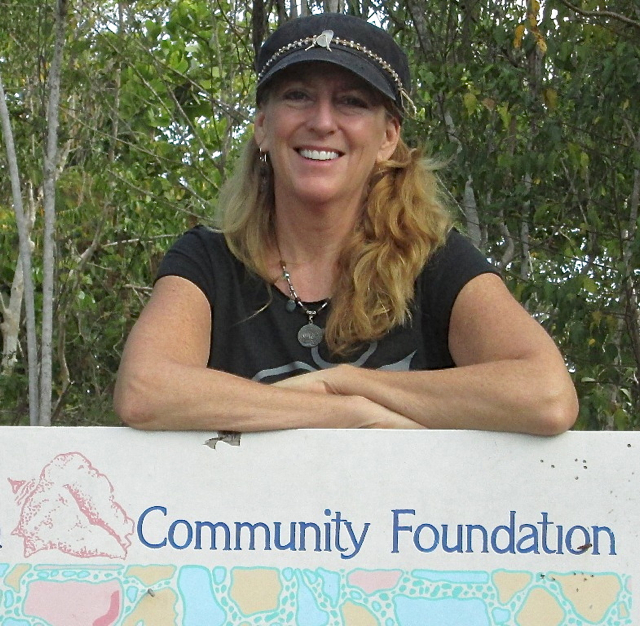
Paths went through the property adjacent to Bellevue Village affordable housing community, all cleared and maintained by Community Foundation volunteers. For now, chairs and chaises left behind at the island’s Dumpsters serve as places to relax until the Community Foundation comes up with funding to build more elegant benches.
“We’re encouraging people to come up here and sit,” Community Foundation Director Celia Kalousek said.
The paths wind through and around the ruins of what remains of an 18th-century cotton plantation. Research done in 2003 shows that two parcels, called Bellevue after its beautiful view and The Gift, now spelled Gifft, were used as a wedding dowry for daughters of the plantocracy. Originally claimed in 1721 by an unidentified person who was granted a tax holiday, the property’s first identified owner was Anna Maria von Holten in the 1728 tax records. She and her husband, Adrian von Beverhoudt, were absentee owners of the cotton plantation, which apparently did not suffer damage during the 1733 slave revolt.
Dr. Cornelius Bodger, who arrived from Denmark with the Danish West Indies Co., was the first resident owner in 1738. The land tax registers for a 14-year period are missing, so no details are available from 1740 to 1754. However in 1755, the records show that Peter von Beverhoudt and his family lived on the working cotton plantation and most likely also grew sugar cane, and quite possibly coffee.
In 1778, a Danish government official and his brother-in-law bought the land, moved the slaves to Annaberg, and records show that the land was uninhabited for about six years. Edward Kenny and his family bought it in 1784 and lived there for three years. The Wood family lived there until right after the 1792 hurricane, which probably damaged the residence and led to their departure.
Between 1792 and 1822, there was intermittent occupation and cultivation. William Turnbull, president of the British Virgin Islands, owned the property and tax records show that it was uninhabited and uncultivated between 1798 and 1810. By 1817 the property was back in the Beverhoudt family.
Records show that the property was uninhabited and uncultivated between 1823 and 1915. However, it is likely that during that 92-year period the common practice of wood harvesting and charcoal burning was undertaken by squattersm and occasionally free and enslaved workers were sent to tend livestock on the property.
“Our goal is to retell the story of life back in that day by creating a historical walking path, and include signage of the flora and fauna as well,” Kalousek said.
Part of that effort includes the development of an orchard.
“Look at the rich soil,” Kalousek said as she led a tour through the property.
The orchard will feature fruit trees native to the Caribbean. They were all cultivated within a mile of the property in the previous century. According to Kalousek, extensive soursop and guava orchards at nearby Estate Susannaberg were productive for many years, and ancient mamee apple trees can be found on the L’Esperance property to the east. Sugar apples, once prolific on island, are now hard to find.
A butterfly garden is growing near the edge of the property closest to Bellevue Village’s community center. It’s a labor of love for volunteer Deanna Somerville, who inherited her passion from her parents, Evelyn and Louis Somerville of Boca Raton, Fla. Her mother donated a butterfly box that anchors the garden on one end.
A garden in the shape of a butterfly is under construction, with Somerville picking up plants along the roadside to fill the garden. One wing will be in yellows, oranges and red plants and the other in blues and purples, Somerville said.
The Community Foundation also plans a round labyrinth surrounded by native plants and trees. In fact, the group has already laid out rebar to mark the inside spokes.
The entire project pulled various entities and agencies together. Students from the nearby Gifft Hill School made signs for trees already planted and built compost boxes. The Island Green Building Association contributed labor. The St. John Historical Society worked on researching the ruins that sit on the property, and the Audubon Society members are helping to identify flora and fauna, Kalousek said.
The clearing began with an $18,000 grant from the Agriculture Department funded through U.S. Department of Agriculture’s Forest Legacy program.
The orchard work will continue with a $15,000 Specialty Crop grant from the same agency. The Community Foundation and its partners will contribute $36,927 in-kind services.
The project needs volunteers, and Kalousek said anyone who wants to help can show up between 8 a.m. to noon on Wednesdays.
The dirt road to the site is located across Gifft Hill Road from the bank of Dumpsters adjacent to a sharp turn in the road. Coming from Centerline Road, it’s just past Bellveue Village.
Volunteers can call 1-340-693-9410.





